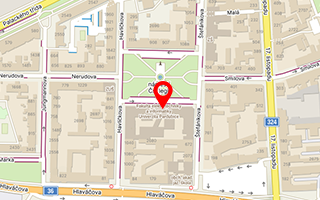The Faculty of Electrical Engineering and Informatics will contribute to increased train safety
Specialists from the Faculty of Electrical Engineering and Informatics (University of Pardubice) have been engaged in RHINOS, a prestigious international project, since the beginning of January 2016. Together with other foreign universities and institutions they will contribute to the effective use of satellite navigation to improve train safety.
There is an unprecedented increased level of pressure exerted by railways and the rail and space industry on the use of satellite navigation for train safety. And so, RHINOS (Railway High Integrity Navigation Overlay System) aims at defining and designing a GNSS-based train localisation system while at the same time fulfilling the highest safety requirements conforming to European rail standards. Incorrectly used satellite navigation could endanger the lives of many people. In fact, it could even be the cause of their death. The RHINOS project is thus expected to ensure that the newly designed localisation system complies with the above-mentioned highest safety objectives. By way of illustration this means that a dangerous error in determining the location of a train using the GNSS principle can occur once in less than 100 000 years!
RHINOS makes use of two navigation systems
This safe train localisation system is primarily designed for the European Train Control System (ETCS). ETCS currently uses costly balises positioned on railways to facilitate the accurate safe train localisation function. RHINOS will replace these physical balises with the help of so-called virtual balises. The objective of the project is to utilise GNSS Safety-of-Life (SoL) services. These were primarily developed for aviation safety operation control.
It is expected that RHINOS will be based on at least two different satellite constellations (GPS and Galileo) and that EGNOS will also be used. The European Geostationary Navigation Overlay Service (EGNOS) provides users with better accuracy of positioning data compared to GPS, especially when it comes to integrity. Another important objective of the project is to identify specific solutions for which it will be possible to develop international standards that can be applied globally. The assumption of the European Commission is that the very same international standardisation will significantly strengthen the competitiveness of ETCS on markets outside of Europe (Australia, China, North and South America, etc.).
The Faculty’s involvement is not due to any random factor, it is deeply rooted in history
The actual idea to use satellite navigation to effectively boost railway safety is not new. The first reflections in this direction originated in the Czech Republic twenty years ago at Czech Railways. A year later, in 1996, Czech Railways opened a specialist unit in Pardubice named Intelligent Systems Laboratory. It was here that the first rail vehicle positioning tests were carried out in the Pardubice – Hradec Králové – Choceň locality. GPS was used. Shortly after being established, the Laboratory struck up cooperation with the University of Pardubice, then the Jan Perner Transport Faculty. This team of Czech experts worked on a significant European project together with other western European colleagues as early as in 1998. It was the Advanced Train Position Locator project, known as APOLO. And so, it is no coincidence that one of the first tests regarding the then developed pan-European satellite system EGNOS known under the acronym ESTB (EGNOS System Testbed) was carried out in eastern Bohemia. The tests were carried out on the Potštejn – Litice nad Orlicí line in close cooperation with the Centre National d’Etudes Spatiales (CNES), Toulouse, France, in 2000.
Since 1999, experts from Pardubice have been members of various international groups of experts, such as the GNSS Rail Advisory Forum in Brussels (1999 – 2000) and UIC Galileo for Rail in Paris (2005 – 2011). They also began to actively engage with experts from the USA specialising in the development of Positive Train Control (PTC) based on the GPS principle. The results of the APOLO project formed the basis for further successful national projects overseen by the Czech Science Foundation (GA CR), the Czech Ministry of Transport and the European Space Agency (ESA). The then newly established Institute of Electrical Engineering and Informatics, which was changed to the Faculty of Electrical Engineering and Informatics in 2008, also became successively involved in these follow-up projects. Researchers from Pardubice presented results in the field at numerous conferences in Europe and abroad. They were invited to lectures at foreign universities and workshops.
How to determine the position of a train?
Over the past two decades, this field has been characteristic in its search for suitable ways to achieve the required safe positioning of trains using the GPS or GLONASS principle. By way of illustration, past research can be described as having been a short segment of a parabola with a gradual increase drawn from point 0. Today, train positions can also be determined, albeit to a limited degree, with the use of other global systems, i.e. Galileo or BeiDou. And that is why apart from achieving required positioning safety, the RHINOS project will also search for solutions that will allow for the effective use of more constellations. Particularly then with respect to the highest achievable availability of absolute train positioning - globally.
So, figuratively speaking, we are now standing at a point on the imaginary parabola from which the curve will steeply go up. The PTC system is being installed on many lines in the USA. The first contracts relating to safe train localisation were signed following several testing schemes. The contracts comply with European railway safety standards and apply to Australia, Europe and the Russian Federation. That is why it will become necessary to draw up international standards regarding the use of GNSS in connection with railways. And that not only to achieve the increased competitiveness of the European industry, but also to ensure required system interoperability on lines interconnecting remote regions, such as Europe and East Asia. Pardubice University experts will also contribute to finding the solutions to these issues within the framework of the RHINOS project.
The Faculty as a member of an international team
The Faculty of Electrical Engineering and Informatics is working on the project together with other institutions. The coordinator of the RHINOS project is Consorzio Universita Industria - Laboratori di Radiocomunicazion (an association of Italian universities known as RadioLabs). Apart from the University of Pardubice, the other participants are: ANSALDO STS (Italy), Deutsches Zentrum für Luft - und Raumfahrt (DLR) (Germany), Nottingham University (Great Britain), SOGEI (Italy) and Stanford University (USA). The GNSS Centre of Excellence (Czech Republic) is a subcontractor of the University of Pardubice. The project became prestigious and really international when scientists from Standard University from the renowned Silicon Valley in California were invited to join the project. They have extensive experience of the development of safety systems based on GNSS for aviation.
The RHINOS project is scheduled to cover a period of 18 months. The organisations involved received a contribution in the amount of EUR 1.5 million from the Horizon 2020 programme, which is an EU framework programme for research and innovation over 7 years (2014 to 2020). Pardubice University’s participation in the project is financed 100 % and it will receive EUR 200 000 (i.e. approximately CZK 5.4 million).
doc. Ing. Aleš Filip, CSc.
Ing. Zdeněk Němec, Ph.D.
Faculty of Electrical Engineering and Informatics, University of Pardubice
Published: 2016-05-03 Updated: Webmaster on 2016-09-08 08:37

